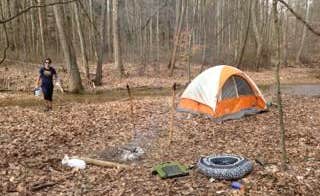Dispersed camping near Shelbyville, Kentucky provides access to backcountry experiences within a reasonable drive. Located in the Ohio River Valley region, campers face temperature variations that can range from below freezing in winter months to humid 90°F conditions in summer. The terrain consists primarily of limestone karst formations creating undulating topography, with several creeks that flow seasonally.
What to do
Hiking challenging trails: The Knobstone Trail offers strenuous hiking opportunities for experienced backpackers. "The KT is rugged and has lots of elevation gains over short distances. Everywhere you hike there are lovely vistas and lots of fossils on the trail snd creek beds," notes reviewer Maris H.
Wildlife observation: Morning hours provide optimal wildlife viewing when animals are most active. "The entire park is just beautiful. It's very family friendly and quiet. The sites are spacious, and there are a lot of nature things to do," reports Susan C. who visited the Knobstone area.
Creek exploration: Seasonal streams throughout the region offer opportunities for wading and natural water features to explore. At Jackson Trailhead, "there's parking after a decrepit gravel road and suitable for camping. There are campsites along the trail just have to find them," according to reviewer loganx11.
What campers like
Fossil hunting: The limestone geology creates excellent opportunities for finding fossils along creek beds and exposed trail sections. As one Knobstone Trail visitor mentioned, "Everywhere you hike there are lovely vistas and lots of fossils on the trail snd creek beds."
Privacy between sites: The dispersed nature of camping provides significant separation between groups. Susan C. notes about Knobstone Trail camping, "The sites are spacious, and there are a lot of nature things to do."
Road crossings for resupply: Multiple access points allow for shorter segment hikes or emergency exits if needed. "There are road crossings every 5 to 10 miles, so if you run out of something or need to bail you can," explains a Knobstone Trail camper.
What you should know
Navigation challenges: Some areas have poor signage or difficult access roads. Desert B. cautions about navigation issues: "Maybe Google Maps took me to the wrong place (probably not). I drove back and forth on the road several times looking for this place. The only thing I found was what I believe was the entrance with a cable across it."
Seasonal bug activity: Insects are particularly active during spring and early summer. Prepare with appropriate clothing and repellent. "Watch out for ticks. My dogs and I got loads of them in April 2020 from Leota to Spurgeon Hollow," warns a regular Knobstone Trail hiker.
Road quality concerns: Many access points require driving on deteriorating forest roads. One Jackson Trailhead camper noted the "decrepit gravel road" leading to suitable camping areas, suggesting high-clearance vehicles may be advantageous.
Tips for camping with families
Pack extra water containers: Limited water sources mean families need to carry additional water, especially for children. "You're never too far from water, although the quality may differ depending on the time of year," notes a Knobstone Trail camper about the variable water conditions.
Plan shorter segments: For families with younger children, utilize the frequent road crossings to create manageable hiking distances. "There are road crossings every 5 to 10 miles," mentions Maris H., which allows for creating family-appropriate hiking segments.
Choose quieter weekdays: Weekend traffic increases significantly at main trailheads. Susan C. describes the Knobstone area as "very family friendly and quiet," but this experience is more likely during weekdays when visitation decreases.
Tips from RVers
High-clearance vehicles recommended: Standard RVs are not suitable for most dispersed camping areas, but high-clearance camping vehicles might access some trailheads. "I drove back and forth on the road several times looking for this place," notes one visitor, highlighting access difficulties.
Base camping alternatives: Consider established campgrounds as base camps for day trips to primitive areas. "Most people, even Hoosiers don't realize the Knobstone Trail exists," suggests many visitors might prefer day hiking from established campgrounds rather than backpacking.
Parking limitations: Trailhead parking areas have limited space and may not accommodate larger vehicles. While "the trailheads all have adequate parking," according to one reviewer, this typically refers to standard vehicle parking rather than RV accommodation.


